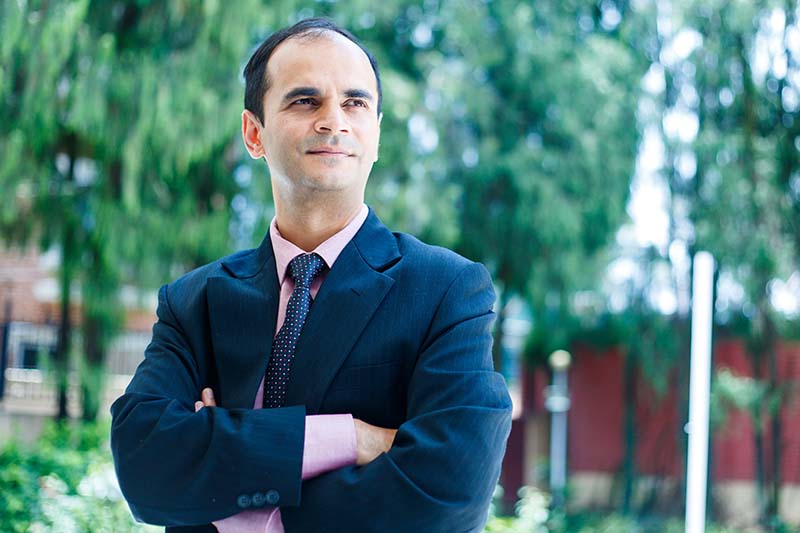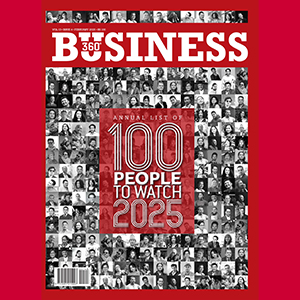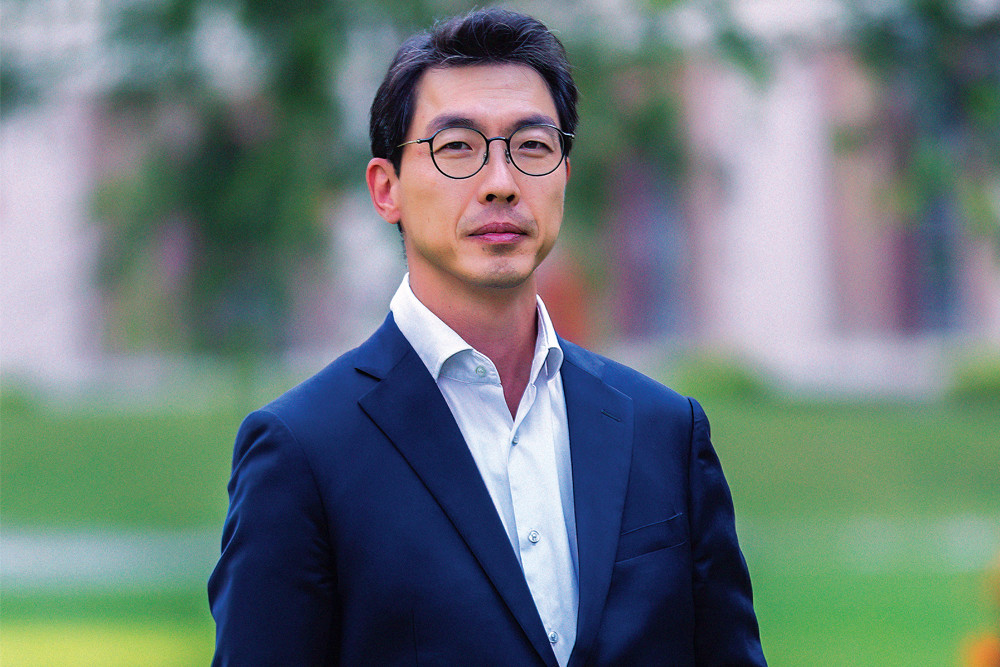
Ghanshyam Upadhyaya is the Joint Secretary at the Ministry of Culture, Tourism and Civil Aviation. It has been five years since he took on this position. He also has the experience of heading the social development division, monitoring division and governance reform at the Prime Minister’s Office. He was previously Under Secretary, Program Director at the National Planning Commission. Business 360 interviewed Upadhyaya on matters related to air safety, air entry points, country’s infrastructure and upcoming tourism campaigns. Excerpts:
About two thirds of the total business of Nepal is with India. It is because of the geography, historic relations, and bilateral ties at the people’s level. One of the ways we can bring about change in trade deficit is through service industry and tourism is one of the agents. In context of tourism, Indian tourists are positioned number one in our list of nationalities visiting Nepal. About 80% of the population of India are Hindus. Every Hindu wants to visit Pashupatinath and Muktinath, and everyone wants to go to the birth place of Lord Buddha. Additionally, Nepal has become the transit point for Mount Kailash.
From tourism perspective, things are looking bright, but,as long as we are reliant on India for import of goods,tourism alone cannot bring about instant and visible balance in the trade deficit with India. Moreover, we have to promote exports and discourage imports. We also need to look for alternative energy to petroleum products and self-dependency on agriculture needs to be promoted.
On January 19, 2018 Nepal was asked to elucidate on the progress in the aviation safety concerns raised by the European Commission (EC) regarding the ban against Nepali Airlines from European Union skies. What is the status?
According to the Director General of Civil Aviation Authority of Nepal (CAAN), efforts have been put on that front. Besides, security concerns of International Civil Aviation Organisation (ICAO) have been met. ICAO has already removed Nepali Airlines from its blacklist. That’s why EC’s clarification is also in the process. Nepal has been put in the security concern list, but the ban will be lifted within a year. Several rounds of meetings have been conducted. High-level officials of CAAN travelled to Belgium in January where they presented the progress status. All matters and concerns raised by EC are under consideration level at present.Keeping in mind the upcoming international airports in Bhairahawa, Pokhara and Nijgadh, Nepal has proposed three new cross-border air entry points over Janakpur, Bhairahawa and Nepalgunj airspaces. What is the update on that?
A technical meeting between CAAN and aviation authority of India will take place soon. And when it recommends the matter, both governments will decide along that line. The date is yet not clear but it will be very soon. Lumbini International Airport is scheduled to go into operations in 2019. That’s why it is high time we expedite the process.Why are things ambiguous?
The competent authority, in this case, is CAAN. They are rigorously engaging to solve the issue. Though the case was endorsed in 2014 but because of the April 2015 earthquake and other matters, it got affected to some level. There were unavoidable circumstances which caused the delay. These entry points are in high priority of the Government of Nepal. There are no problems on both sides, Nepal and India. It is just that there are technical matters to be resolved. In the first round of meeting, the technical experts will propose coordination and implementation agendas which the upper level needs to recognise.Although three are five exit points: Bhairahawa, Biratnagar, Kakkarbhitta, Janakpur and Mahendranagar for international airlines, Simara is the only entry route for aircrafts flying into Nepal. And has Nepal been trying to increase the entry points since the last nine years?
In my opinion, everything is related to the state of our civil aviation. The sorry condition of our national flight carrier, many ups and downs in the leadership of civil aviation, inability on the part of the leadership to concentrate on work resulted in the delay. Moreover, attention of civil aviation had been more towards removing Nepal from EC’s security concern list. Also, in the second international airport, construction issues were there. Major focus was put into Tribhuvan International Airport. All these might have diverted them from the core objectives. But the focus is now on handling these issues sooner than later and we are hopeful.The government is now trying to expedite the process because of the upcoming international airports…
Definitely. The pressure has been created. Within five years, two additional international airports will be in operation. The increased number of flights between India and Nepal will automatically boost tourism on both sides. However, we hit the wall because of the single entry point to Nepal. Nepal-India Tourism Working Group Meeting was scheduled for February 24-25 but the Indian side requested to delay it for some time. It is probable that within two months, this meeting will be held in Nepal. Regarding aviation, we will raise giving priority to private airlines as well. The way we treat India, it will be in reciprocity from the Indian side too. Our priority is how to go together to promote Nepal and India internationally. Just like Buddhist circuit, Hindu circuit should be formulated. Joint promotion issues along with Leave Travel Concession (LTC) issues, capacity-building, research and exchange of information and data are to be discussed in the meeting. Trade deficit with India in FY 2016/17 is recorded at Rs. 491 billion when in 2015/16 it was Rs. 447.7 billion. It is said that the government needs to focus on hydropower and tourism sectors to bring down ballooning trade deficit with India. What are your thoughts?
Trade deficit with India in FY 2016/17 is recorded at Rs. 491 billion when in 2015/16 it was Rs. 447.7 billion. It is said that the government needs to focus on hydropower and tourism sectors to bring down ballooning trade deficit with India. What are your thoughts?
About two thirds of the total business of Nepal is with India. It is because of the geography, historic relations, and bilateral ties at the people’s level. One of the ways we can bring about change in trade deficit is through service industry and tourism is one of the agents. In context of tourism, Indian tourists are positioned number one in our list of nationalities visiting Nepal. About 80% of the population of India are Hindus. Every Hindu wants to visit Pashupatinath and Muktinath, and everyone wants to go to the birth place of Lord Buddha. Additionally, Nepal has become the transit point for Mount Kailash.
From tourism perspective, things are looking bright, but,as long as we are reliant on India for import of goods,tourism alone cannot bring about instant and visible balance in the trade deficit with India. Moreover, we have to promote exports and discourage imports. We also need to look for alternative energy to petroleum products and self-dependency on agriculture needs to be promoted.
Indian and Chinese tourists come in large scores. Has the government planned anything specific for them?
Of the total tourists that visit Nepal, 25% are Indians and Chinese make up 20-22%. Nepal Tourism Board (NTB)’s budget for this fiscal year is designed specifically for them. One third of the population of this world is around us. That’s our opportunity. Moreover, China has predicted that by 2020, there will be about 200 million Chinese outbound tourists every year. Just imagine 200 million in a year. If we can bring only 1% that will be two million. We are trying to harness that opportunity.How are you planning to do that?
Through massive marketing by the tourism board. We have declared 2020 as Visit Nepal Year. Moreover, Nepal Embassy in China, Beijing, in collaboration with Chinese Government celebrated 2017 as Nepal Visit Year China. In 2017, we witnessed 40% growth of Chinese tourists in Nepal. Discussions are underway at the government level of both countries for VNY 2020. NTB is working rigorously on that. Besides, we are doing China based marketing strategies and massive campaigning and advertisement through Chinese media. We are also inviting Chinese celebrities and bloggers to visit Nepal.Branding and marketing is one thing, but the country should be ready to cater to the tourists. What we fail in is infrastructure. Your thoughts…
Definitely. The bottleneck is our infrastructure. And the very first bottleneck is connectivity. We don’t have regular flights, too many constraints on the part of our airport. What I think is that if we keep marketing constantly and do not necessarily do massive marketing, but better the condition of TIA, and add Lumbini and Bhairahawa airports, it will become two million tourists from one million straightaway. The number of people who wish to visit Nepal is really high. But lack of better access is limiting our potential to entertain all those who aspire to visit our country. Secondly, those who come to Nepal, are not well facilitated with better network of transport. Third is the lack of diversification of tourist destinations. Chitwan and Pokhara have been enjoying attention but the private sector fails to entertain the far west, Rara, or mid-western region. That’s why we are celebrating 2020 as Visit Nepal Year. We are struggling because of poor infrastructure but I do see better future in tourism. Within five years, we can double the numbers.You talked about diversification of tourist destinations. Who identifies these new locales?
Destinations are already identified. Everybody wants to visit Khaptad and Rara. But the issue rests with the private sector. They should make tour packages and the government should facilitate them. The thing is government does not make packages. Private sector has a great role in tourism. That’s why we are participating and partnering with the private sector to promote Nepal internationally with the mechanism of NTB. The government’s work is towards facilitating policy instruments. For example, if the private sector makes a package for Rara, the government can promote Rara through NTB and provide subsidy to tour operators that make such packages. The kind of procedure that is required for those constructing five star hotels in Kathmandu, the same can be facilitated for those constructing hotels outside Kathmandu and out of the proverbial triangle:Lumbini, Pokhara and Chitwan.Do you think your target for 2020 will be made easier now that the country is in a federal government structure?
Nepal is now a federal country and in the same light, federalisation of the bureaucracy in NTB is underway. That’s a different and new avenue to promote Nepal. International marketing will be done by the central government. But how to attract tourists to their provinces and their destinations in the provincial and local level needs to be planned by the federal states. That way tourists will stay longer and their expenditure will be more. That will bring good result for the economy too. We are hopeful that VNY 2020 will be a success.Do you see the effectiveness of these sorts of campaigns? We had Visit Nepal campaign many times before.
Tourism is a crazy business. It is not only a business, but also a hobby and people have psychological attachment to it. Campaigns have larger effect on this industry. They affect the growth rate of the tourists. We are the pioneer country for tourism in South Asian region but the irony is that we are not getting better tourists compared to other countries. We have not achieved exponential results in terms of the number of tourists. We also lag behind in terms of the quality of tourists. If truth be told, we have faced a lot of setbacks in the tourism sector. The setbacks are not just the earthquake and the blockade, before that the avalanche and long political instability and the security situation imposed by EC.Sentimental value contributes to the flow of tourists in any region.
Lonely Planet acknowledged Nepal as the World’s Best Value Destination for 2017. The tourism industry is the only one that revived itself within two years after the devastating earthquake. The other sectors have not revived yet. In 2016 we were in the process of revival and by the end of 2017, we witnessed 25% growth in the number of tourists. We achieved 1 million target in 2017. And we are planning 1.5 million i.e 50% within two years.Hotels and resorts inside national parks and wildlife reserves have been barred by the government. Do you think it was a good decision?
As the Joint Secretary of the Ministry of Tourism and moreover as someone who is heading the promotion division, hotels and resorts inside national parks and wildlife reserves was a unique taste for international tourists. It was something different. In terms of tourism promotion that proved as a milestone. Now for whatever reason the ban was placed, an inter-ministerial coordination is required to resolve the matter. It is necessary to open such types of hotels and unique adventure offerings in our tourism sector.The cultural heritage sites that were destroyed by the 2015 earthquake have not received much care, in fact they are being neglected by the government…
We are planning to complete all reconstruction projects in three years time. There are so many responsible organisations for reconstruction. There is Nepal Reconstruction Authority (NRA), line ministries and competent departments, local governments like Kathmandu Metropolitan City. The problem with them is they are not working in a well-coordinated manner. About the cultural part, the popular voice is to have them revived as per the old archeological structure. For example, in the case of Rani Pokhari, the call to bring it back to the old Malla period glory is resonating from all quarters. But our Ministry says that it should be brought back to the condition that it was in in April 2015 before the earthquake hit us. The rare availability of building materials to get its Malla period look, shortage of manpower and the concern of the local community in its construction …all these delay the reconstruction process. But the government is streamlining these concerns. We are doing a series of meetings to get a solution to all the existing concerns.What is the budget the government has allocated for VNY 2020?
It’s not clear now. We don’t have to hurry for the budget allocation for something as far as 2020. But we are planning. 2018 is the starting year. 2019 will be the main campaigning year. And 2020 is the year of celebration. As soon as the new minister is appointed, we will make committees which will decide on the programmes. And once this is done, the budget will be discussed. The portion of private sector, NTB and government in the campaign will also be decided thereafter. Since VNY 2020 is high priority of GoN, I don’t think budget will be an issue.How should we read the interest of international investors in Nepal—for example opening of international chain hotels like Marriot and Sheraton?
GoN is inviting foreign investors to Nepal as tourism has the most potential. They can get more by investing in Nepal. Hurdles are non-existent. We are promoting foreign direct investment in this manner. Political stability gives meaning. And politics is the fountain of policies. We have to be client-oriented, investor-friendly. We also need to work on administrative work culture. We need helpful people and helping media. There are various sectors that contribute to the overall success.
Published Date: March 15, 2018, 12:00 am
Post Comment
E-Magazine
RELATED Face 2 Face



.jpg)
.jpg)
.jpg)